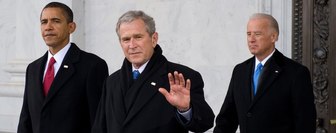There are three things that matter about the US election result, seen from my pollster’s point of view. What do we learn about the role of demographics against attitudes in determining outcome? What might the result mean for the next UK general election? And why did we get that Mitt Romney phantom swing?
A lot has been written about how divided a country the US has become, with support for the two parties split down race, age and gender lines. But looking more closely, are demographics really the most important angle? True, YouGov’s final survey (of 36,000 Americans, which predicted the result exactly right) showed a 20 per cent gap between the genders, with men preferring Romney by 8 per cent and women opting for Barack Obama by 12 per cent. Or look at age: 40 is the crossing point when one moves from being a likely Obama voter to a likely Romney one. And the other big divide is race.
Important, yes, but you could also argue that demographics are an imperfect proxy for the likelihood of holding certain attitudes. Those attitudes are more important predictors. The exit poll shows Obama won 81 per cent of those who believe in a bigger role for government: he took 87 per cent of those wanting to preserve or expand the 2010 health care law and he won 67 per cent of those who think abortion should be legal. So if I could have just one piece of information about a random voter to predict who they would choose, it would not be demographic, it would be their preference for a bigger or smaller role for government.
The exit poll also shed light on what the outcome might be at the next British election. How has a western leader survived in the current economic circumstances? That the economy was the number one issue in America is clear: Obama secured 4 per cent of those who thought Romney would best handle the economy, and Romney took 1 per cent of those who thought Obama would. Not surprisingly, those who felt better off than they did four years ago opted for the incumbent (84 per cent) and those who felt worse off backed the challenger (80 per cent). But perhaps it was how the largest group split that was ultimately decisive: those who felt their financial situation was about the same voted 58 per cent to 40 per cent in Obama’s favour.
This goes against the conventional model of voting behaviour, which sees economic conditions as a strong predictor of outcome. But an answer makes sense of this: the exact timing of the economic crash. The exit poll showed that most blamed the Bush administration for the mess. David Cameron could possibly find himself the beneficiary of a similar effect, as our polling shows more people blame Labour than Conservatives for the cuts.
From a simple horse-race point of view, Obama’s victory shouldn’t have come as a surprise. He was consistently ahead, except for the period after the first presidential debate. This was the one time we saw some sheer bad polling: Gallup, for example, showed a 7 percent Romney lead and even in their final poll had Romney a squeak ahead. Most of the others also entertained a big Romney swing, though they tended to finally converge to somewhere near the result.
The truth – and this is important – is that there never was a swing. We interviewed 33,000 people before the first debate and re-interviewed 25,000 of them afterwards. The change was less than 1 per cent. You can’t do better than large-scale high-response re-interviews to measure change. But we found one interesting detail: those who had previously said they preferred Obama were significantly less likely to respond to the post-debate survey. Perhaps they felt weakened by the negative buzz around a bad debating performance. They hadn’t changed their mind, they just didn’t want to talk about it.
So Romney’s phantom swing was entirely an illusion of traditional polling methodology. That methodology is no more “random selection” than any other, as people can self-deselect depending on their attitudes (just as they can with all other methodologies). But with panel-based re-interviews you get more data, and can create better models.
This may seem an obscure point, but it matters: phantom swings are exciting but distorting. They plague campaigns. And the overreaction of commentators could negatively influence tight races. Perhaps you’ll permit YouGov a little smugness: we not only got the overall result exactly right, we called all states correctly except for Florida, where we gave Romney a 1 per cent lead but which, after all, turned out to be statistically a dead-heat.









